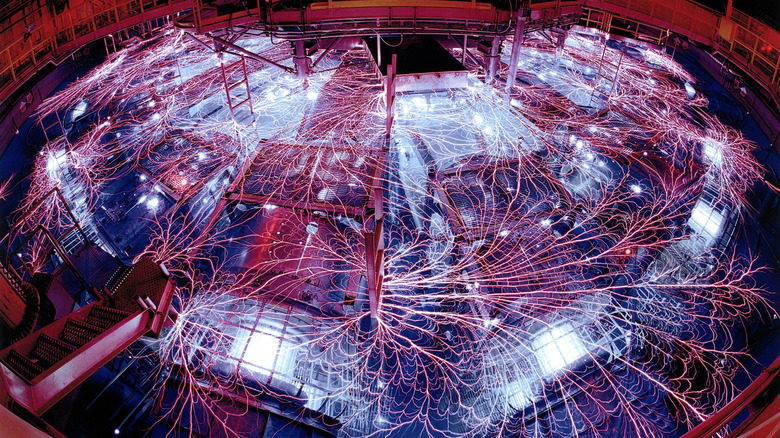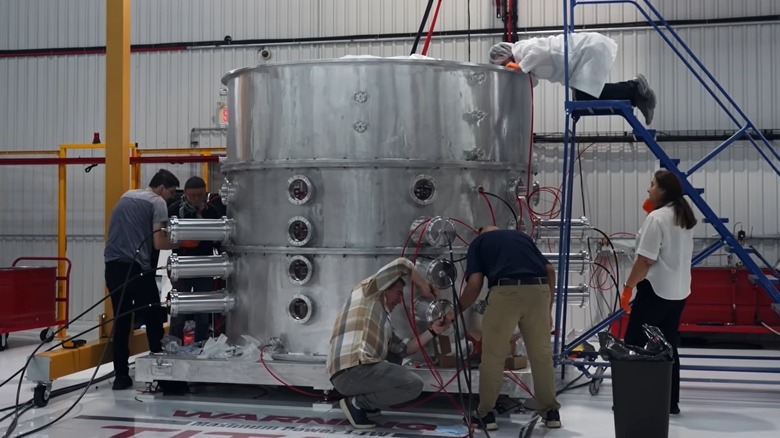 Eyeem Mobile Gmbh/Getty Images
Eyeem Mobile Gmbh/Getty Images
On average, a single lightning bolt produces 300 million volts and 30,000 amps of electrical current. This begs the question — just what type of scenario would require a generator that could create the equivalent energy of 800 lightning bolts? This isn't a generator that you approach with a can of gasoline, or one that can be used as a domestic backup should the power fail, nor is it even something needed to supply industrial amounts of power — the generator in question goes far beyond that and moves into the realm of nuclear fusion applications.
Nuclear fusion is often cited as being the power of the future. Fundamentally, nuclear fusion — a field that's seen major breakthroughs recently — is the same process that powers the Sun. The Titan impedance-matched Marx generator (IMG) is an experimental, research-grade, pulsed-power system that's designed to unleash ultra-intense electrical discharges. This is one of the companion technologies helping to realise the dream of nuclear fusion.
As we explore later, it's based on a Marx generator, a technology that's over a century old. Its potential applications stretch across fusion research, advanced materials testing, and even national security research. This is a cutting-edge piece of electrical engineering that operates at the extreme limits of what electrical systems can handle.
What is an impedance matched Marx generator?
 U.S. Department of Energy/Wikimedia Commons
U.S. Department of Energy/Wikimedia Commons
Let's begin with an electrifying fact: for 100 nanoseconds, the Titan generator consumes more power than New York, Dubai, Tokyo, and Shanghai combined. For just that fraction of a second, this beast requires more energy than four of the most power-hungry cities on the planet. This is extreme engineering indeed, but what is an IMG? While Erwin Marx may not be as well-known as influential inventors like Nikola Tesla, he did invent the generator that bears his name. He developed the first Marx Generator in 1924. The principle behind the idea is remarkably simple. A low voltage is used to charge up a bank of capacitors, which then release the stored electricity in series to generate high-voltage pulses. Essentially, this is the same principle as blowing up a balloon and then letting all the air discharge at one time.
IMGs are designed to optimize this power delivery. As the name suggests, IMGs match the output impedance with the load impedance. This approach has several advantages over "traditional" Marx Generators. Starting with the architecture, an IMG reduces the requirement for additional pulse-compression hardware. This not only simplifies the design, but it also increases the energy efficiency of the generator (which is just as well, given that 100-nanosecond power demand). Additionally, the "impedance matching" trait of the generator ensures that more of the stored energy reaches its target. In fact, proper impedance matching allows energy-delivering efficiencies approaching 90%, making them far more efficient than conventional Marx generators.
Delivering Titanic amounts of power
 Jason Carman/YouTube
Jason Carman/YouTube
The Titan generator is manufactured by Delaware-based Fuse Energy Technologies. The company says its mission is to speed up our transition to fusion energy and to make sure that America and its allies remain relevant in the field. The Titan is an important part of this roadmap. More specifically, Fuse Energy intends to connect sixteen Titan modules in parallel to create a facility dubbed "Z-Star." The company calls this facility an "intermediate next-generation pulsed-power (NGPP) facility," and it's hoped that this allows it to expand its commercial and governmental customer base.
Although experimental results describe a six-stage version delivering 330 GW of peak power, the full 14-stage Titan is expected to reach a terawatt of output. To give some context as to just how much power this actually is, it's worth noting that in April 2024, the entire wind power generating capacity of the US was 150.1 GW, and the biggest deployed wind turbine produces a mere 15 megawatts. While the basic idea behind a Marx generator is relatively simple, the Titan IMG is anything but. To produce such extreme pulses, the 22-ton Titan is made up of over 40,000 parts, uses 5,283 gallons (20,000 liters) of oil, and continually circulates 169 gallons (640 liters) of deionized water. The result of all this technology? A cutting-edge generator that — with one shot – can deliver the equivalent energy of over 800 lightning bolts firing simultaneously, and a machine that Fuse hopes will support future fusion-energy research.



